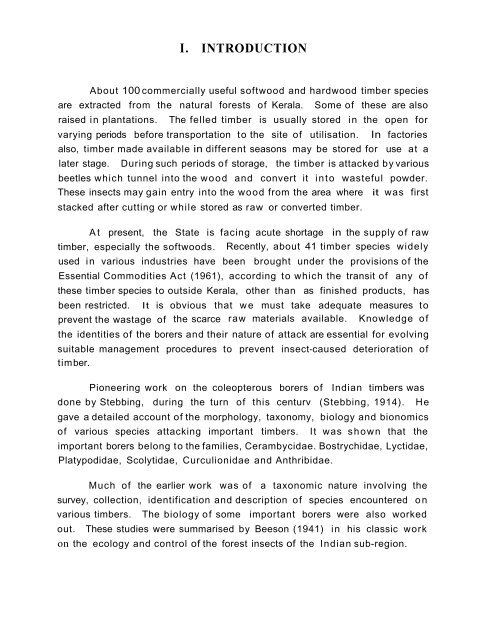a survey of beetles damaging commercially impotrtant ... - Icrisat.ac.in
a survey of beetles damaging commercially impotrtant ... - Icrisat.ac.in
a survey of beetles damaging commercially impotrtant ... - Icrisat.ac.in
Create successful ePaper yourself
Turn your PDF publications into a flip-book with our unique Google optimized e-Paper software.
I. INTRODUCTIONAbout 100 <strong>commercially</strong> useful s<strong>of</strong>twood and hardwood timber speciesare extr<strong>ac</strong>ted from the natural forests <strong>of</strong> Kerala.raised <strong>in</strong> plantations.Some <strong>of</strong> these are alsoThe felled timber is usually stored <strong>in</strong> the open forvary<strong>in</strong>g periods before transportation to the site <strong>of</strong> utilisation.In f<strong>ac</strong>toriesalso, timber made available <strong>in</strong> different seasons may be stored for use at alater stage.Dur<strong>in</strong>g such periods <strong>of</strong> storage, the timber is att<strong>ac</strong>ked by various<strong>beetles</strong> which tunnel <strong>in</strong>to the wood and convert it <strong>in</strong>to wasteful powder.These <strong>in</strong>sects may ga<strong>in</strong> entry <strong>in</strong>to the wood from the area where it was firstst<strong>ac</strong>ked after cutt<strong>in</strong>g or while stored as raw or converted timber.At present, the State is f<strong>ac</strong><strong>in</strong>g <strong>ac</strong>ute shortage <strong>in</strong> the supply <strong>of</strong> rawtimber, especially the s<strong>of</strong>twoods. Recently, about 41 timber species widelyused <strong>in</strong> various <strong>in</strong>dustries have been brought under the provisions <strong>of</strong> theEssential Commodities Act (1961), <strong>ac</strong>cord<strong>in</strong>g to which the transit <strong>of</strong> any o fthese timber species to outside Kerala, other than as f<strong>in</strong>ished products, hasbeen restricted. It is obvious that we must take adequate measures toprevent the wastage <strong>of</strong> the scarce raw materials available. Knowledge <strong>of</strong>the identities <strong>of</strong> the borers and their nature <strong>of</strong> att<strong>ac</strong>k are essential for evolv<strong>in</strong>gsuitable management procedures to prevent <strong>in</strong>sect-caused deterioration <strong>of</strong>tim ber.Pioneer<strong>in</strong>g work on the coleopterous borers <strong>of</strong> Indian timbers wasdone by Stebb<strong>in</strong>g, dur<strong>in</strong>g the turn <strong>of</strong> this centurv (Stebb<strong>in</strong>g, 1914).gave a detailed <strong>ac</strong>count <strong>of</strong> the morphology, taxonomy, biology and bionomics<strong>of</strong> various species att<strong>ac</strong>k<strong>in</strong>g important timbers.HeIt was shown that theimportant borers belong to the families, Cerambycidae. Bostrychidae, Lyctidae,Platypodidae, Scolytidae, Curculionidae and Anthribidae.Much <strong>of</strong> the earlier work was <strong>of</strong> a taxonomic nature <strong>in</strong>volv<strong>in</strong>g the<strong>survey</strong>, collection, identification and description <strong>of</strong> species encountered onvarious timbers.The biology <strong>of</strong> some important borers were also workedout. These studies were summarised by Beeson (1941) <strong>in</strong> his classic workon the ecology and control <strong>of</strong> the forest <strong>in</strong>sects <strong>of</strong> the Indian sub-region.

















